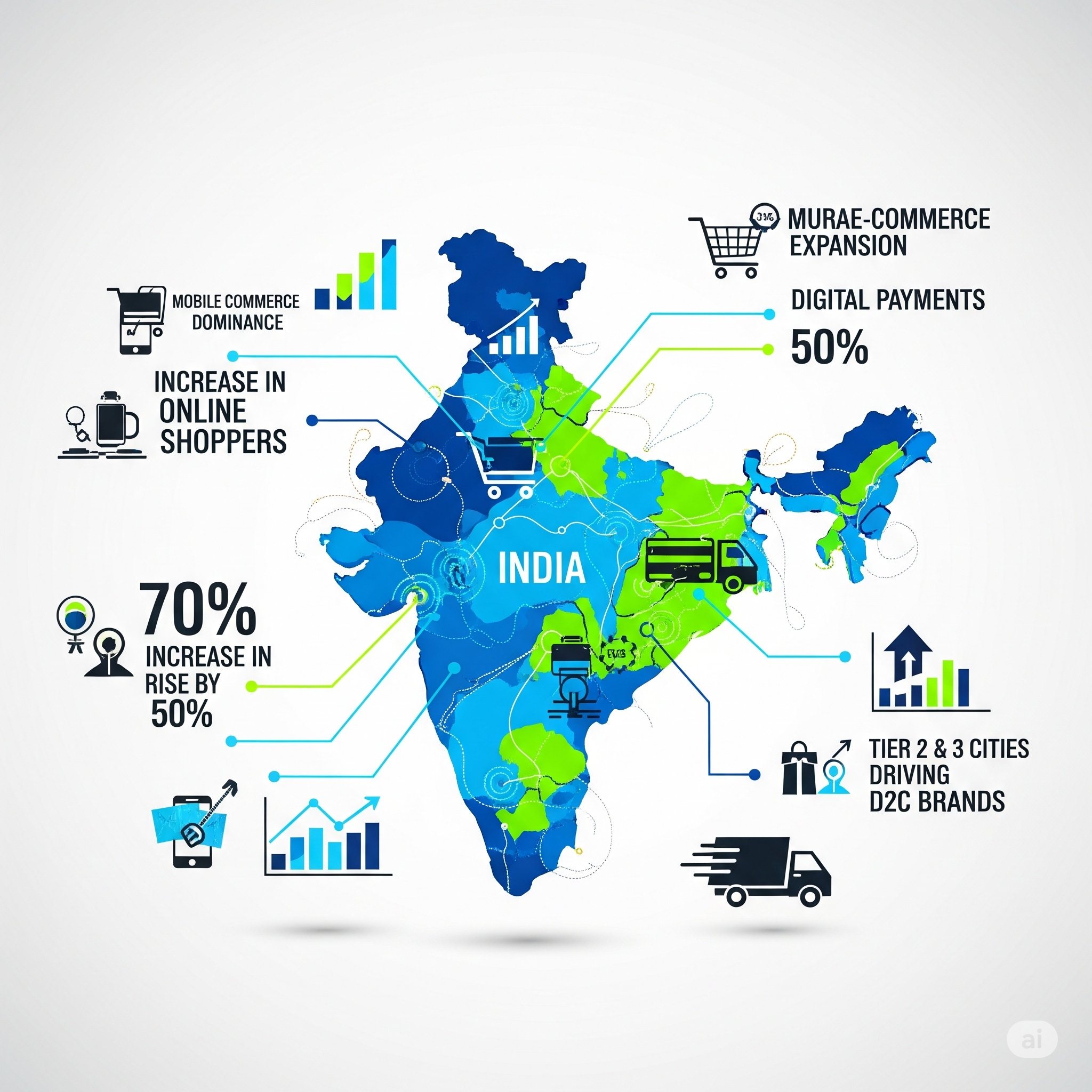
The Rise of Hyper-Convenience: Quick Commerce and Mobile-First Experiences
India’s online retail market is in the midst of a profound transformation, evolving at an unprecedented pace. From bustling metropolitan hubs to the burgeoning Tier 2 and 3 cities, the convenience and accessibility of online shopping India are redefining consumer behavior. This digital revolution, often referred to as digital commerce India, is not merely a shift in how goods are bought and sold; it’s a fundamental reshaping of the entire retail landscape, driven by innovation, increasing digital literacy, and supportive government initiatives. Understanding these ecommerce trends in India is crucial for businesses aiming to thrive in this dynamic environment.
The India ecommerce growth story is nothing short of remarkable. Fuelled by a massive and young population, increasing internet penetration, and affordable smartphone access, the market size continues to expand rapidly. Projections indicate a sustained upward trajectory, making India one of the most attractive global destinations for online retail. However, this growth also presents unique ecommerce challenges India, particularly concerning infrastructure and consumer trust, which are being actively addressed by both industry players and policymakers.
Riding the Digital Wave: Key Ecommerce Trends Shaping India’s Future
One of the most prominent emerging ecommerce trends India is the surge of quick commerce (q-commerce). This model, characterized by ultra-fast deliveries, typically within minutes, has become a game-changer for urban consumers. Platforms like Zepto, Blinkit, and Swiggy Instamart are catering to the instant gratification needs of customers, delivering groceries, medicines, and daily essentials at lightning speed. This trend underscores the growing consumer demand for seamless and immediate access to products, pushing the boundaries of traditional logistics and supply chain India.
Complementing the rise of q-commerce is the undisputed dominance of mobile commerce (m-commerce) India. The vast majority of online transactions in India now occur via smartphones. This mobile-first approach dictates how ecommerce platforms India are designed, prioritizing intuitive user interfaces, fast loading times, and mobile payment integrations. Businesses that fail to optimize their online presence for mobile risk being left behind in this highly competitive market.
Digital Payments: Fueling the Transactional Shift
The widespread adoption of digital payments India has been a monumental factor in accelerating India ecommerce growth. The Unified Payments Interface (UPI) has revolutionized the payment landscape, offering instant, secure, and convenient transactions. This shift from a predominantly cash-on-delivery (COD) economy to one embracing cashless transactions has significantly boosted consumer confidence in online purchases. Innovations like Buy Now Pay Later (BNPL) India options are further empowering consumers, making high-value purchases more accessible and driving higher average order values. This robust digital payment infrastructure is a cornerstone of India’s evolving digital commerce ecosystem.
The Power of Niche: Direct-to-Consumer (D2C) Brands and Social Commerce
Beyond the major marketplaces, a significant trend shaping the future of ecommerce India is the proliferation of Direct-to-Consumer (D2C) brands India. These brands bypass traditional retail channels, selling directly to consumers through their own websites and online stores. This allows them greater control over brand messaging, customer experience, and pricing. Success stories like Mamaearth, boAt, and Licious exemplify the potential of the D2C model in India, demonstrating how a strong brand narrative and direct customer engagement can resonate deeply with consumers.
Furthermore, the lines between social interaction and shopping are blurring with the rapid expansion of social commerce India. Platforms like Instagram, Facebook, and WhatsApp are increasingly becoming integral to the shopping journey, facilitating product discovery, reviews, and even direct purchases. Influencer marketing and live shopping events are powerful tools for D2C brands and established players alike to connect with consumers on a more personal level, leveraging the power of community and trust.
Expanding Horizons: Tier 2 and 3 Cities & Rural Adoption
While metros have long been the stronghold of ecommerce India, the next wave of growth is undeniably emanating from Tier 2 and 3 cities e-commerce and increasingly, rural e-commerce adoption. Rising disposable incomes, improved internet connectivity, and a growing aspiration for branded goods are driving online consumption in these regions. However, serving these markets comes with its own set of logistics and supply chain India challenges, including last-mile delivery, payment preferences (where COD might still be prevalent), and language barriers. Businesses are investing in localized strategies, building robust delivery networks, and offering regional language interfaces to tap into this massive, underserved consumer base. Understanding the nuances of consumer behavior online India in these regions is paramount for success.
Future Forward: Personalization, Sustainability, and Regulatory Landscape
Looking ahead, several other trends are poised to significantly impact the India online retail market. Personalized shopping experience, driven by Artificial Intelligence (AI) and machine learning, will become increasingly sophisticated. From tailored product recommendations to customized marketing messages, personalization will be key to customer retention strategies. Similarly, voice commerce India, though nascent, holds immense potential as smart speaker adoption grows.
Moreover, sustainable e-commerce India is gaining traction. As environmental awareness increases, consumers are gravitating towards brands that prioritize eco-friendly packaging, ethical sourcing, and responsible business practices. Companies are beginning to focus on reducing their carbon footprint, from optimizing delivery routes to offering recyclable packaging.
Finally, the government regulations e-commerce India play a critical role in shaping the industry’s future. Recent policy changes aim to ensure fair trade practices, protect consumer rights, prevent monopolistic behavior, and enhance data protection. While these regulations can sometimes present compliance hurdles, they ultimately contribute to building a more trustworthy and stable environment for both businesses and consumers.
In conclusion, India’s ecommerce landscape is a vibrant, dynamic, and rapidly evolving ecosystem. The convergence of technological advancements, changing consumer preferences, and supportive policies is creating unprecedented opportunities. Businesses that are agile, consumer-centric, and willing to innovate across areas like logistics, payments, and customer engagement will be well-positioned to ride this digital wave and capture the immense potential of ecommerce in India.


